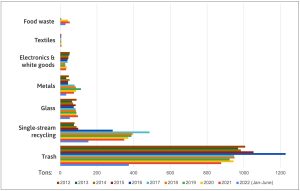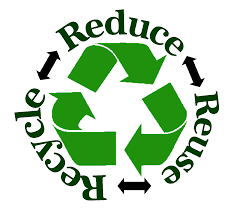By Alice Waugh
Editor’s note: A huge thank-you to Susan Donaldson, DPW office manager, for her prompt and helpful answers and explanations as the Lincoln Squirrel was researching and writing these articles.
Also in this series:
- Part 4: Beyond the transfer station
- Part 3: Recycling beyond single-stream
- Part 2: Trash
- Part 1: Single-stream recycling
Lincoln’s recycling rate (the proportion of recyclables diverted from the trash) since 2012 has averaged about 40%, which is slightly better than the statewide average of 33% but well below the national leaders, San Francisco and Los Angeles, which divert about 80 percent of their waste from landfills. So there’s definitely room for improvement in both how much Lincolnites recycle, and how correctly they recycle by putting items in the correct bin at the transfer station.
One method that some towns are using to encourage more recycling is “pay as you throw” (PAYT), where residents pay for trash disposal per unit of waste discarded rather than solely through a fixed townwide fee or tax. “It’s equivalent to putting a price tag on each container of trash that’s placed at the curb or taken to the landfill or transfer station for disposal,” notes a DEP implementation guide for starting PAYT programs. As of 2021, more than 150 cities and towns in Massachusetts had some type of PAYT program in place.
The Holy Grail of recycling and trash management is “zero waste,” where almost nothing goes in the trash and everything we use is subject to the five R’s: Refuse, Reduce, Reuse, Recycle, and Rot. “Refuse” at the top of the pyramid means the first step is to say no to disposable single-use plastic, coffee cups, utensils, straws, shopping bags, food packaging, and anything else you could replace with a reusable or compostable option.
Meanwhile, at the transfer station, it’s often hard to know whether something is recyclable or not, so the DPW encourages residents to ask a staff member where things should go rather than just guess or “wishcycle.” “It makes you have to think,” noted Susan Donaldson, DPW office manager.
The department will hold education days at the transfer station starting in September, and a short version of the new rules is being included with new transfer station stickers that residents get in the mail (they’re required as of September 1).
“We want to encourage people to read the rules and regulations because that tells you everything,” Donaldson said.
Resources
- Lincoln DPW Transfer Station
- How and Where to Recycle (MassDEP)
- Recyclopedia (MassDEP)
- Beyond the Bin Recycling Directory
- Moving Toward a Zero Waste Massachusetts (Keep Massachusetts Beautiful)
- Zero Waste Living, the 80/20 Way: The Busy Person’s Guide to a Lighter Footprint (book)
- How to Go (Almost) Zero Waste: Over 150 Steps to More Sustainable Living at Home, School, Work, and Beyond (book)
Lincoln’s costs to haul and process materials (January – June 2022)
| Material | Cost |
|---|---|
| Trash | $48,918 |
| Single-stream recyclables | $6,102 |
| Glass | $5,301 |
| Metal | $1,588 |
| TVs | $880 |
| Black Earth Compost | $4,524 |
| Recycling rebate | +$4,725 |
| Textiles rebate | +$1,321 |
| Total costs (Jan-Jun) | $61,267 |
Costs are fee per ton, less the value of materials.
Tons of material hauled in Lincoln (2012 – June 2022)

(Source for table and chart: Susan Donaldson, Lincoln DPW, and 2019 DPW presentation)
Notes:
- Starting in July 2016, paper and cardboard were included in single-stream recycling.
- In 2021, there were also 8 tons of mattresses recycled.

Thanks for this series. Informative and helpful for us as we discovered our mistakes and are now improving our selective attention to what goes where and how we can reduce our consumption of non recylable elements so common in our lives.